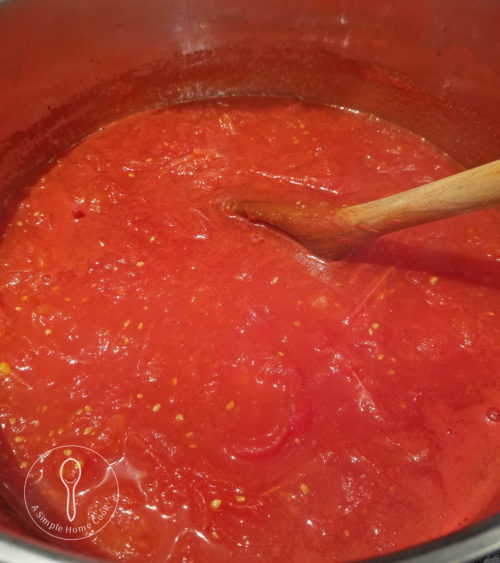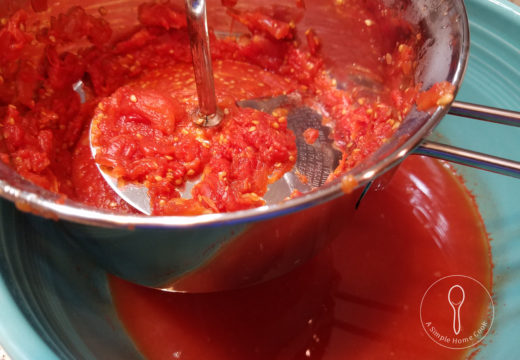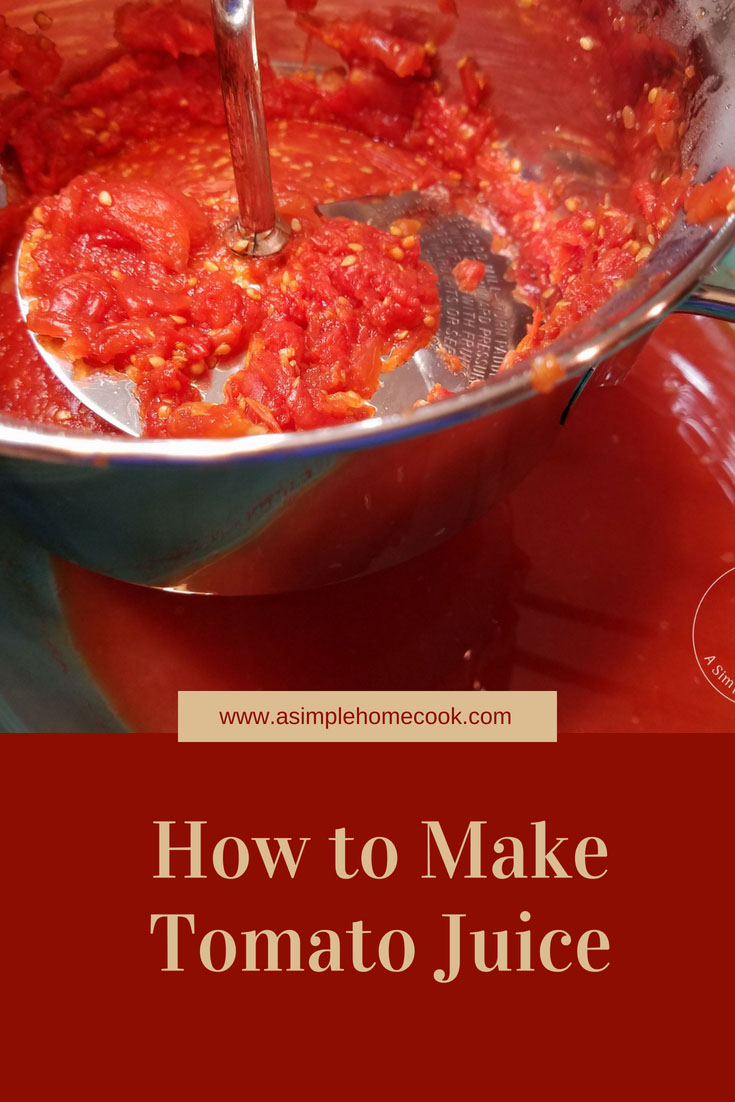This article contains links for products I use or mention. As an Amazon Associate, I earn from qualifying purchases. This does not affect your purchase price if you use the embedded links.
The first time I ever cooked with commercially canned tomato juice it was quite a shock. I could not believe how salty it tasted. Plus, I really did not like its flavor. It did not taste like it could be the same substance that my family had been canning all of my life. I eventually learned to buy low sodium juice from a glass bottle whenever possible. However, it is just not the same. So, why not just can my own?
At one point in time, I had vowed never to can tomato juice or any other tomato product again. It was after my husband and I had planted more than a hundred tomato plants on my parents’ farm. My loving parents had kept them alive during the spring cold snaps by covering and uncovering them, we all tended to them until they were just about ripe. Then, my husband took a job 60 miles away leaving me with the pleasure of canning many, many bushels of tomatoes.
I really did not believe I would never can tomatoes again. However, life events did prevent me from canning tomatoes for more than a decade. Now, I can tomatoes that someone else grows and I purchase by the box. Because I am not sure of what specific type of tomato I purchase, I follow the USDA guidelines for adding acidity. As many of the more modern varieties do not have the acidic content of the older ones, it is recommended that you add citric acid or commercial lemon juice to the jars of tomatoes when canning.
Besides that one difference, I make tomato juice just like my mom. I keep it simple.
To begin, I clean and quarter the tomatoes. As I cut them into quarters, I place them in a large heavy-bottomed, non-reactive pot. I sometimes mash the first layer or so with a potato masher to get some of the juice out of the tomatoes. When the pot is full, I add just a little cold water if I have not pressed out any or enough juice to keep the tomatoes from sticking to the bottom as they start to cook. DO NOT ADD TOO MUCH WATER OR ELSE YOU WILL DILUTE THE JUICE. If you add water, your juice will separate. If you do not add water and mash the first tomatoes and slowly add others as they cook, your juice may not separate (or at least not separate as much). Personally, the juice separating into pulp and liquid does not bother me. If I am turning a bushel or two of tomatoes into juice, I feel I have too much work to take the time to mash the tomatoes in hopes that my juice will not separate. I just shake the juice before using.
Once the tomatoes have cooked until soft and released much of their liquid and pulp, I run the juice through a Foley Food Mill to separate the skins, seeds, etc. from the juice. I squeeze the juice into a crock, crock bow, or another non-reactive container. My mom owned a Squeezo Food Strainer that someone gave her, but she did not like it as well as the food mill. However, a lot of people seem to prefer the Squeezo or the less expensive Victorio Food Strainer.
The process of making juice is the same whether you make just a little or a lot. If you want to make just want to make enough to use in a particular recipe, just follow the steps to the point of preparing the jars in the recipe (they are the steps I have described so far).
How to Make Tomato Juice
Ingredients
- About a half a bushel, 2 peck, or 22-25 lb. of ripe tomatoes
- 1 cup cold water (OPTIONAL/IF NEEDED)
- 1 tsp. canning salt (or Kosher salt that does not contain anti-caking ingredients will work), per quart
- 1/2 tsp.citric acid or 2 Tbsp. lemon juice, per quart
Instructions
- Clean and cut tomatoes into quarters (halves for small tomatoes)
- Place tomatoes in a large, heavy-bottomed pot over medium to med.-high heat.
- Mash a layer of tomatoes with a potato masher AND/OR add 1/2 to 1 cup of cold water to tomatoes.
- Continue cutting tomatoes into pot until the pot is nearly full or until all tomatoes are in the pot.
- Cook until tomatoes are softened and have released much of their juice and pulp, stirring often.
- Remove tomatoes from heat.
- Run tomatoes through a food mill or strainer to separate the juice and pulp from the seeds, peel, etc. Place strainer over a crock, ceramic, glass or other non-reactive container.
- TO USE WITHOUT CANNING:
- Store in glass or other non-reactive containers in the refrigerator.
- TO CAN IN A WATER BATH:
- Meanwhile, clean and sterilize 7 to 9 quart jars. Sterilize matching lids.
- Pour hot juice into the hot jars and add salt (if desired) and citric acid.
- Wipe rims of jars with a clean, damp towel.
- Place hot lids on jars and tighten lids with rings.
- Partially fill a water bath canner with hot water and place over heat. Make sure the canner has a wire rack or other device so the jars do not sit on the bottom of the canner.
- Carefully place the tighten jars in the canner.
- Add more very hot/boiling water to cover jars according to water bath canner directions, usually 2 inches above the tops of the jars for processing longer than 30 minutes.
- Process according to USDA guidelines. Currently, 40 minutes for 1,000 ft. above sea level or 45 for 1,001 to 3,000 ft. above sea level. (This is MUCH longer than the former guidelines).
- Again, follow your canner/USDA directions to remove jars from the canner. For safety, do not have cold air blowing directly on the jars as you remove them from the canner. Place them on kitchen towels, etc. and not directly on a cold surface to cool.
Notes
You can make as little or as much juice as you desire. The recipe is just for a traditional canner full.
A steam canner and or a pressure canner can be used instead of water bath. Just follow the directions on the canner and/or from the USDA.





